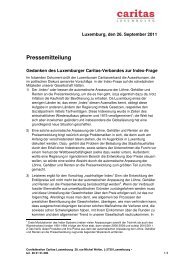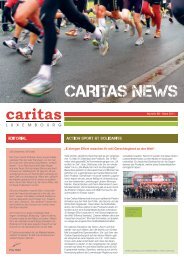Sozialalmanach - Caritas Luxembourg
Sozialalmanach - Caritas Luxembourg
Sozialalmanach - Caritas Luxembourg
Create successful ePaper yourself
Turn your PDF publications into a flip-book with our unique Google optimized e-Paper software.
The above three features of loose monetary policy, the savings and trade imbalance,<br />
and lax regulation ultimately exacerbated the pro-cyclical and self-reinforcing nature of the<br />
downturn. For the past two decades, increase in US debt came from the financial innovation,<br />
rather than the real economy. Once, a home owner took out a mortgage, and household<br />
debt increased. But since the late 1990s, mortgages could be used to secure mortgagebacked<br />
securities, and those securities could in turn be used to secure a collateralised<br />
debt obligation. The end result was more borrowing, but no more real economy activity.<br />
Moreover, when assets, driven by cheap money, came to be bought not because of the rate<br />
of return on investment but in anticipation that such assets and securities can be sold at a<br />
higher price, the stage was set for an asset bubble of overvalued stocks in relation to real<br />
economy fundamentals. The history of the current crisis is therefore perhaps less a tale<br />
of greed or improvident borrowing than it is a tale of profligate lending. Examining the<br />
supply of credit provides a far more telling analysis than looking at its demand by ordinary<br />
consumers. Maier 40 claims that while governments adopted the imperatives of balanced<br />
budgets, inflation targeting, deregulation, and privatisation (thus constraining the money<br />
supply), the private financial sector was allowed to use financial innovation to create as much<br />
money as it saw fit. This led to massive – though fictitious – wealth creation throughout the<br />
1990s. It was thus not greed, but rather the necessity and availability of credit that led to the<br />
overwhelming indebtedness of American citizens. In retrospect, it can be argued that the<br />
compression of incomes in the US throughout the neo-liberal period was compensated by a<br />
reduction in household savings and mounting private indebtedness, which allowed spending<br />
patterns to be kept virtually unchanged. At the same time, limited social safety nets forced<br />
the government to pursue active macroeconomic policies to fight unemployment, which<br />
increased government indebtedness as well. Thus, growth was maintained at the price of<br />
increasing public and private indebtedness, adding to the already existing macro imbalance.<br />
Privatized money production on a hitherto unknown scale can be understood as a<br />
response to the general stagnation of growth and profitability after the 1970s. The inevitable<br />
result was a rapidly growing debt pyramid vastly in excess of the real economy’s ability<br />
to pay. In the era of neo-liberalism, structural inequalities were allowed to persist and<br />
widen further, both within and between countries. Indeed, Tony Atkinson 41 finds that<br />
while many developed countries saw their GDP increase by up to 25% over the past fifteen<br />
years, median incomes barely rose at all (and in some countries even declined), revealing<br />
a highly skewed distribution of growth. In macroeconomic parlance, increased inequality<br />
implies weak domestic demand: the skewed wealth distribution and high unemployment<br />
40 Maier (2009).<br />
41 Atkinson et al. (2002).<br />
166








